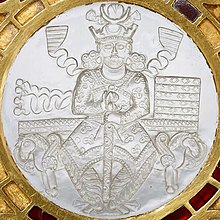
Back Chosrau I. ALS كسرى الأول Arabic كسرى الاول ARZ I Xosrov Azerbaijani انوشیروان AZB Хосров I Ануширван Bulgarian প্রথম খসরু Bengali/Bangla Cosroes I Catalan ئەنووشیروان CKB Husrav I. Czech
| Khosrow I Xosrōe 𐭧𐭥𐭮𐭫𐭥𐭣𐭩 | |
|---|---|
| King of Kings of Iran and non-Iran[a] | |
 Khosrow I on an ornamental plate in BnF Museum | |
| Shahanshah of the Sasanian Empire | |
| Reign | 13 September 531 – February 579 |
| Predecessor | Kavad I |
| Successor | Hormizd IV |
| Born | 512–514 Ardestan, Sasanian Empire |
| Died | February 579 (aged 65–67) Ctesiphon, Sasanian Empire |
| Spouse | Khazar princess |
| Issue |
|
| House | House of Sasan |
| Father | Kavad I |
| Mother | Ispahbudhan noblewoman |
| Religion | Zoroastrianism |
Khosrow I (also spelled Khosrau, Khusro or Chosroes; Middle Persian: 𐭧𐭥𐭮𐭫𐭥𐭣𐭩; New Persian: خسرو [xosˈroʊ̯]), traditionally known by his epithet of Anushirvan (انوشيروان [ænuːʃi:rˈvɔːn] "the Immortal Soul"), was the Sasanian King of Kings of Iran from 531 to 579. He was the son and successor of Kavad I (r. 488–496, 498/9–531).
Inheriting a reinvigorated empire at war with the Byzantines, Khosrow I made a peace treaty with them in 532, known as the Perpetual Peace, in which the Byzantine emperor Justinian I paid 11,000 pounds of gold to the Sasanians. Khosrow then focused on consolidating his power, executing conspirators, including his uncle Bawi. Dissatisfied with the actions of the Byzantine clients and vassals, the Ghassanids, and encouraged by the Ostrogoth envoys from Italy, Khosrow violated the peace treaty and declared war against the Byzantines in 540. He sacked the major city of Antioch and deported its population to Persia. In 541, he invaded Lazica and made it an Iranian protectorate, thus initiating the Lazic War. In 545, the two empires agreed to halt the wars in Mesopotamia and Syria, while it waged on in Lazica. A truce was made in 557, and by 562 a Fifty-Year Peace Treaty was made.
In 572, Justin II, the successor of Justinian, broke the peace treaty and sent a Byzantine force into the Sasanian region of Arzanene. The following year, Khosrow besieged and captured the important Byzantine fortress-city of Dara, which led Justin II to insanity. The war would last till 591, outliving Khosrow. Khosrow's wars were not only based in the west. To the east, in an alliance with the Göktürks, he finally put an end to the Hephthalite Empire, which had inflicted a handful of defeats on the Sasanians in the 5th-century, killing Khosrow's grandfather Peroz I. To the south, Iranian forces led by Wahrez defeated the Aksumites and conquered Yemen.
Khosrow I was known for his character, virtues and knowledge. During his ambitious reign, he continued his father's project of making major social, military, and economic reforms, promoting the welfare of the people, increasing state revenues, establishing a professional army, and founding or rebuilding many cities, palaces, and much infrastructure. He was interested in literature and philosophy, and under his reign, art and science flourished in Iran. He was the most distinguished of the Sasanian kings, and his name became, like that of Caesar in the history of Rome, a designation of the Sasanian kings.
At the time of his death, the Sasanian Empire had reached its greatest extent since Shapur II, stretching from Yemen in the west to Gandhara in the east. He was succeeded by his son Hormizd IV.
Cite error: There are <ref group=lower-alpha> tags or {{efn}} templates on this page, but the references will not show without a {{reflist|group=lower-alpha}} template or {{notelist}} template (see the help page).
© MMXXIII Rich X Search. We shall prevail. All rights reserved. Rich X Search